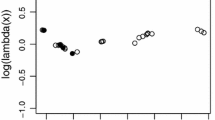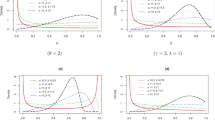Abstract
In reliability and biometry, it is common practice to choose a failure model by first assessing the failure rate function subjectively, and then invoking the well known “exponentiation formula”. The derivation of this formula is based on the assumption that the underlying failure distribution be absolutely continuous. Thus, implicit in the above approach is the understanding that the selected failure distribution will be absolutely continuous. The purpose of this note is to point out that the absolute continuity may fail when the failure rate is assessed conditionally, and in particular when it is conditioned on certain types of covariates, called “internal covariates”. When such is the case, the exponentiation formula should not be used.
Similar content being viewed by others
References
R. E. Barlow and F. Proschan,Statistical Theory of Reliability and Life Testing, 2nd ed. Silver Spring, MD: To Begin With, 1981.
D. R. Cox, “Regression Models and Life Tables (with Discussion),”J. R. Statist. Soc., Ser. B vol. 39 pp. 86–94. 1972.
T. R. Fleming and D. P. Harrington,Counting Processes and Survival Analysis. New York: John Wiley, 1991.
J. D. Kalbfleisch and R. L. Prentice,The Statistical Analysis of Failure Time Data, New York: John Wiley, 1980.
S. Lydersen,Reliability Testing Based on Deterioration Measurements, Doctoral Dissertation. University of Trondheim, Norway, 1988.
R. L. Prentice, J. D. Kalbfleisch, A. V. Peterson Jr, N. Flournoy, V. T. Farewell, and N. E. Breslow, “The Analysis of Failure Times in the Presence of Competing Risks,”Biometrics vol. 34 pp. 541–54, 1979.
N. D. Singpurwalla, “Survival in Dynamic Environments,”Statistical Science vol. 10 no. 1, to appear, 1995.
N. D. Singpurwalla and M. Youngreen, “Multivariate Distributions Induced by Dynamic Environments,”Scandinavian Journal of Statistics vol. 20 pp. 251–261, 1993.
S. M. Wiederhorn and E. R. Fuller Jr., “Structural Reliability of Ceramic Materials,”Mat. Sci. Eng. vol. 71 pp. 169–86, 1985.
A. Yashin and E. Arjas, “A Note on Random Intensities and Conditional Survival Functions,”J. Appl. Prob. vol. 25 pp. 630–635, 1988.
Author information
Authors and Affiliations
Rights and permissions
About this article
Cite this article
Singpurwalla, N.D., Wilson, S.P. The exponentiation formula of reliability and survival: Does it always hold?. Lifetime Data Anal 1, 187–194 (1995). https://doi.org/10.1007/BF00985769
Received:
Accepted:
Issue Date:
DOI: https://doi.org/10.1007/BF00985769




